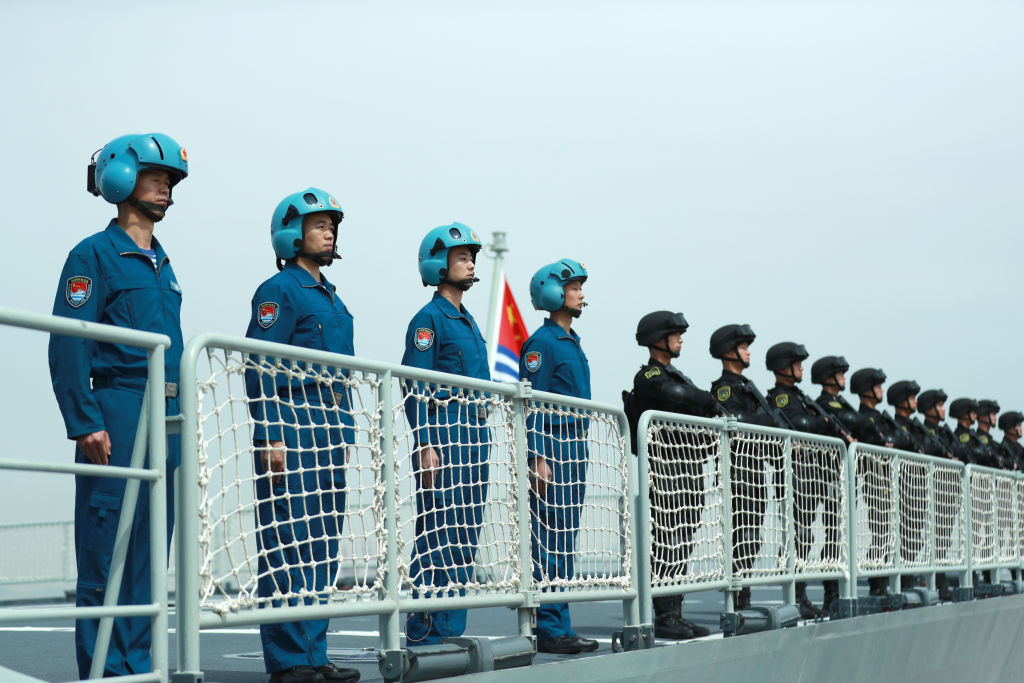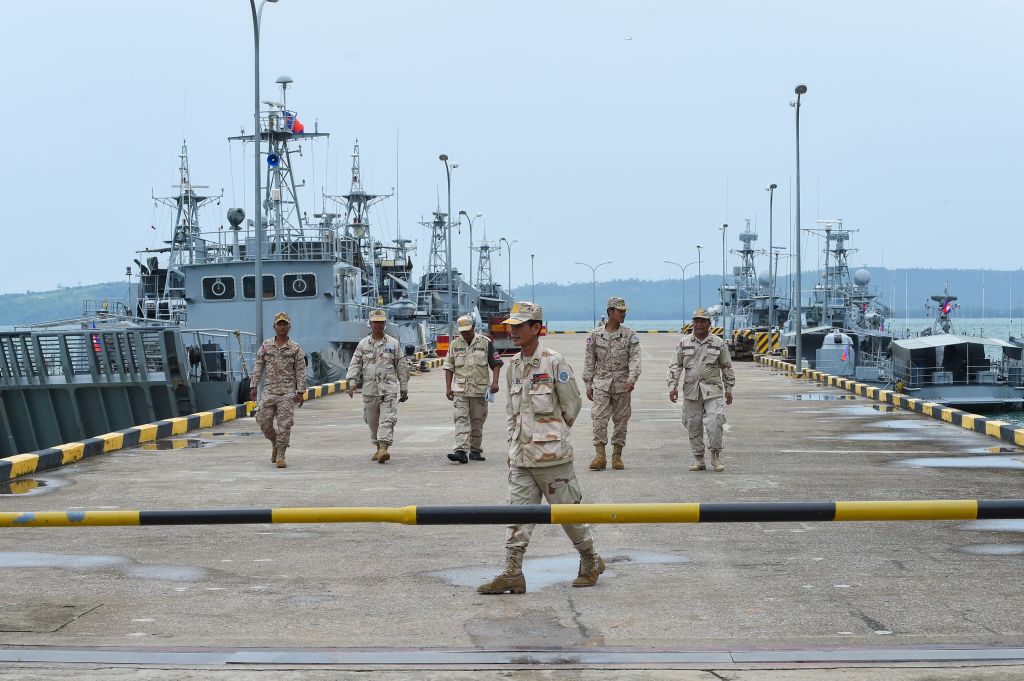
In October 2020, satellite photos showed that the Cambodian government had demolished two American-built facilities at the Southeast Asian nation’s Ream Naval Base—despite Washington offering to renovate them.
On June 9, China is set to break ground on a People’s Liberation Army (PLA) naval facility at the same base, according to reports first published in the Washington Post. It’s a clear sign of Beijing’s increasingly robust power projection in the Asia-Pacific as it seeks to counter a U.S. policy of containment.
Chinese and Cambodian officials have denied that there will be a permanent PLA presence at Ream. But the Post says a Beijing official has confirmed that the Chinese military, and Chinese scientists, will use a “portion” of the base.
Read More: The U.S. Is Losing a Strategic Nuclear-Armed Ally to China
The Post story chimes with a 2019 report by the Wall Street Journal that said China had signed a 30-year secret deal for its military to use Ream. U.S. diplomatic sources told TIME they believe there will be at least a semi-permanent Chinese military presence there.
“Geopolitical competition with the U.S. is increasingly becoming the main lens in which the Chinese leadership is looking at foreign policy and its international behavior more broadly,” says Helena Legarda, lead analyst for the Mercator Institute for China Studies in Berlin.

A New Era of U.S.-China Competition
China for years has been building fortifications on rocks and reefs in the disputed South China Sea, and in 2017 opened its only official overseas base in Djibouti (where the U.S., France, Japan and Italy also have bases.)
Beijing has also opened a military outpost in Tajikistan, near the border with Afghanistan, and is reportedly building a port facility with possible military uses in the United Arab Emirates. In April, a security deal between China and the Solomon Islands was leaked online, and subsequently confirmed by Beijing, which allows China to send armed police and military personnel to the South Pacific nation in what some U.S. officials believe may be the precursor to a permanent military presence.
The establishment of a Chinese naval base in Cambodia would boost Beijing’s aspirations of becoming a true global power with a network of military facilities around the world. That, combined with the Biden administration’s vow to compete with China, risks heightened tensions in the region.
“The big picture is that the region is becoming more militarized,” says Professor Jonathan Sullivan, director of China programs at the Asia Research Institute of U.K.’s Nottingham University. “Not just through U.S. and China, but with others increasing defense spending in response, which increases risk given that the two major actors are in explicit competition and actively building alliances and capacity.”
China has long had designs on becoming the leading strategic power in the Asia-Pacific but would struggle to challenge U.S. hegemony without overseas bases. According to a 2021 Pentagon report, China is “seeking to establish a more robust overseas logistics and basing infrastructure … to support naval, air, ground, cyber, and space power projection.” Other than Cambodia, it has “likely considered a number of countries,” including Thailand, Singapore, Indonesia, Pakistan, Sri Lanka and Tanzania.
Read More: The U.S and China Are Battling for Influence in Latin America
In practical terms, a Cambodia base will allow China to deploy its warships and coastguard vessels at short notice around the region, rather than sail them over long distances during which their movements can be tracked and countered. In addition, logistics and intelligence monitoring would be enhanced by easier access to Southeast Asian sea lanes like the vital Straits of Malacca.
Southeast Asia has been backsliding democratically, following military coups in Thailand in 2014 and Myanmar last year, and the astonishing political rehabilitation of the notorious Marcos family in the Philippines. But Cambodia is the ASEAN nation seen as closest to Beijing, which has, for a long time, courted Prime Minister Hun Sen with billions of dollars in murky infrastructure loans and development projects involving close cronies. In 2017, then U.S. Ambassador to Cambodia William Heidt said that the Cambodian government was “not interested in a positive relationship” with the U.S.
China’s footprint in Cambodia has only grown since. Cambodia has repeatedly been the sole ASEAN member to scupper joint communiques on the disputed South China Sea, even sharing drafts of them with Chinese officials according to some reports.
It remains to be seen how other ASEAN states will react to the Ream Naval Base news. A China-wary Vietnam and a new administration in the Philippines could react in unpredictable ways. However, says Sullivan, “If the reaction is minor, it may suggest other possibilities for China, which is increasingly motivated to secure these kinds of cooperation.”

How the U.S. and Allies Are Pushing Back
Canberra is playing a key role in Washington’s containment strategy. Already, Australia’s new Prime Minister Anthony Albanese has called on Beijing to be open about its intentions in Cambodia. “We’ve been aware of Beijing’s activity at Ream for some time,” Albanese told reporters during a visit to Indonesia on Tuesday. “We encourage Beijing to be transparent about its intent and to ensure that its activities support regional security and stability.”
In late May, Foreign Minister Wang Yi completed a tour of the South Pacific, with the aim of sealing a pact on security and development between China and 10 island nations. China’s proposal was shelved at a meeting in Fiji by nations wary of being caught between Washington and Beijing, but several bilateral deals were signed. Not to be outdone, Australia dispatched its own foreign minister, the newly appointed Penny Wong, to the South Pacific last week to shore up support in what it has traditionally assumed to be its sphere of influence. “China has made its intentions clear [but] so too are the intentions of the new Australian government,” Wong said in a statement.
China meanwhile raised concerns at the International Atomic Energy Agency Board of Governors meeting on Monday over the AUKUS trilateral security agreement, which will see the U.S. and U.K. give Australia help to build nuclear submarines.
Read More: Biden’s Focus on ‘Shared Values’ May Be a Blunder in Asia
But alongside the South Pacific, Southeast Asia is equally emerging as a key battleground for influence between China and the U.S., which is ASEAN’s second largest trade partner after China, but still its largest source of Foreign Direct Investment. Last month, Washington hosted a ASEAN-U.S. Special Summit to promote “peace, security and stability” in the region.
Beijing can be expected to match and even attempt to outdo Washington’s outreach. “The strategic calculus for China in Southeast Asia still accentuates economic cooperation—the bet being that more countries will perceive benefits in keeping China onside,” says Sullivan.
Legarda says that China’s courting of the Global South, including Southeast Asia, is part of Beijing’s desire to build a coalition of countries to push back against a U.S.-dominated global order. “The more that Beijing sees itself as being encircled by an emerging coalition of Western powers and their allies and partners in the region, the harder it’s going to push back.”
More Must-Reads from TIME
- Why Trump’s Message Worked on Latino Men
- What Trump’s Win Could Mean for Housing
- The 100 Must-Read Books of 2024
- Sleep Doctors Share the 1 Tip That’s Changed Their Lives
- Column: Let’s Bring Back Romance
- What It’s Like to Have Long COVID As a Kid
- FX’s Say Nothing Is the Must-Watch Political Thriller of 2024
- Merle Bombardieri Is Helping People Make the Baby Decision
Write to Charlie Campbell at charlie.campbell@time.com